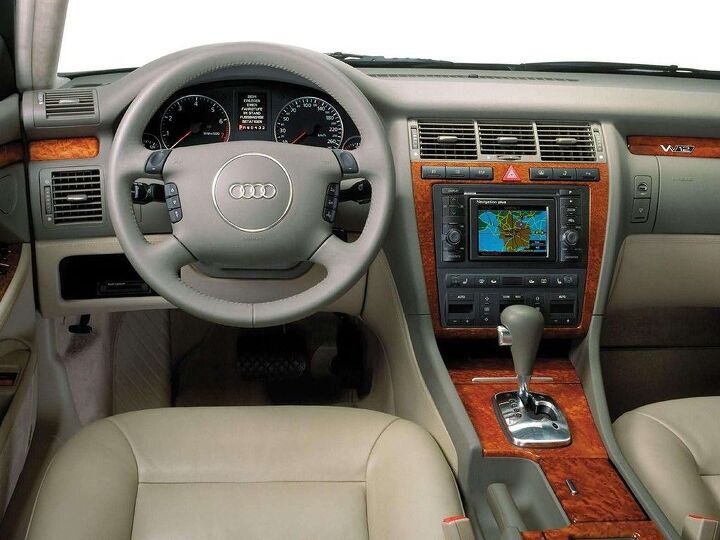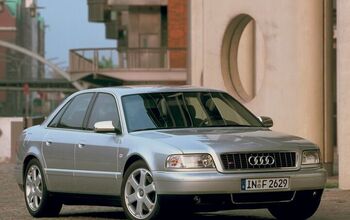Rare Rides: An Almost New Audi S8 From 2001 (Part I)

Rare Rides has featured the predecessor of today’s sedan previously, in a very pearly 1990 V8 Quattro. After Audi spent a few years unsuccessfully trying to sell its first-ever attempt at a flagship full-size sedan, it took the lessons learned from the D1 and developed the D2 A8 and S8.
Today we’ll focus primarily on the A8 foundations that made the S8 possible. Work on the D2 platform began in 1982 when Ferdinand Piech signed a development contract with Aluminum Company of America (you’d probably call it Alcoa). The goal of the agreement was the use of aluminum technology to design a sedan that was lighter than other cars of a similar size class.
The weight saving via lighter metals would make up for the heavy Quattro all-wheel-drive system, which was a given in any flagship Audi. Not eager to repeat the same platform sharing mistake as with the V8 Quattro, the D2 was not an evolution of the steel D1, but rather an entirely new aluminum monocoque platform. Audi dubbed it the ASF, or Audi Space Frame. The Space Frame’s logo was proudly displayed on the lower b-pillars of every A8.
The new A8 was presented at the 1994 Geneva Auto Show and went into production later that year. At the start Audi’s new offering wasn’t quite ready for North American duty: A8 did not arrive in the US until the 1997 model year, and when it did it was more limited in scope than other markets. North American bound A8s were all equipped with Quattro all-wheel drive and (for obvious reasons) a five-speed automatic transmission. While markets outside of North America were offered V6 engines of gasoline and diesel persuasion, all North American A8s were equipped with Audi’s 4.2-liter V8. All North American examples were standard-wheelbase through 1999, but the long-wheelbase arrived for 2000. The L offered five additional inches of rear legroom and meant the lineup was more competitive with offerings from BMW and Mercedes-Benz that came with length. An ultimate version with a 6.0-liter W12 engine was offered from 2001 and was very expensive.
We’ve got the foundations covered, so in Part II we’ll talk about Audi’s transformation of the A8 into a high-performance sports sedan. And I’ll show you the S8 for sale that’s hardly been used.
[Images: Audi]

Interested in lots of cars and their various historical contexts. Started writing articles for TTAC in late 2016, when my first posts were QOTDs. From there I started a few new series like Rare Rides, Buy/Drive/Burn, Abandoned History, and most recently Rare Rides Icons. Operating from a home base in Cincinnati, Ohio, a relative auto journalist dead zone. Many of my articles are prompted by something I'll see on social media that sparks my interest and causes me to research. Finding articles and information from the early days of the internet and beyond that covers the little details lost to time: trim packages, color and wheel choices, interior fabrics. Beyond those, I'm fascinated by automotive industry experiments, both failures and successes. Lately I've taken an interest in AI, and generating "what if" type images for car models long dead. Reincarnating a modern Toyota Paseo, Lincoln Mark IX, or Isuzu Trooper through a text prompt is fun. Fun to post them on Twitter too, and watch people overreact. To that end, the social media I use most is Twitter, @CoreyLewis86. I also contribute pieces for Forbes Wheels and Forbes Home.
More by Corey Lewis
Latest Car Reviews
Read moreLatest Product Reviews
Read moreRecent Comments
- 3-On-The-Tree Tassos, I’m have several different responses yeti your question.[list=1][*] I didn’t buy the corvette for the sole purpose of highway travail, I got it because my dad had a 57 Corvette with 2 four barrel carbs and. 283 V8. I wanted a corvette and a friend who has a custom car performance shop said to get the newest one you could afford.[/*][*]. Letting a car sit is the worst thing for it so it was my daily driver when I was still in the army 30 miles to the base round trip, 160 miles to Tucson form my doctors appointments and VA stuff. My POS 2014 F150 was constantly in the shop for both turbos, two rear main seals, timing chain, transmission. So I was in the process of selling that.[/*][*]But the most important point is that everyone has an opinion and it doesn’t matter what car a person buys or what they use it for.[/*][/list=1]
- EBFlex About time the corpse does something right.I wonder where he got the idea....
- Ajla And in case anyone was interested, yes this tariff does also apply to Polestars, Lincolns, Teslas, Buicks, etc.
- SCE to AUX NPR had an interesting piece on this situation just yesterday, and it turns out that Biden has actually expanded the Trump China tariffs rather than roll them back.However, rather than using the usual shotgun approach employed by past Presidents, Biden's tariff hikes are directed at green/clean energy items which also include non-automotive things such as solar panels.So it looks like the IRA's selective anti-China incentives are part of a larger green agenda, but the plan could backfire if consumers simply choose non-green products instead.Not to mention that it takes gobs of tax money to create the jobs our leaders promise. One calculation put the cost of each new US job created in the solar panel industry at $800k (grain of salt here).Historically, tariffs have been applied after elections, as a reward to those who supported the winning candidate. Of course, this one is happening before the election. Both have political timing, but their economic benefit is doubtful at best, usually injuring the nation who imposes the tariffs.The EU is also getting in on the act, so we could be facing an economic world war over the sourcing of green products. Sadly, if China wasn't an oppressive communist state, we wouldn't even be having this discussion.
- BlackEldo My initial reaction to the interior was "well, they have to leave something on the table to sell the equivalent-sized Lexus." Then I saw the MSRP...




































Comments
Join the conversation
A friend traded his A4 for his sister's A6 ( it was too big for her ) then, a year later, traded the A6 for his parent's neighbour's S8, which was too big for the wife's liking. A4 to S8 in a year - for free. I was with him when the driver's door suddenly decided to not latch anymore: a CDN$900 fix. The central HVAC tunnel would often fill with water, too, even with the windshield drains absolutely clear. Seeing the engine that far forward in the engine bay was always off-putting for me. Otherwise a great car, if you can afford the upkeep.
I loved these when they were current. Having owned a 2002 S4, however, has all but ruined Audi's for me, this one included. Were they as unreliable as the B5s of the day?